The Walt Disney Company wants you to believe that The Lion King belongs in this Read-Watch. Never mind that the film is usually classified as a Disney original. In the corporate version of events, The Lion King was inspired not, say, by a desire on the part of Disney executives to capitalize on the company’s success with films featuring cute singing animals, but entirely by the desire to bring Hamlet to its natural environment out on the savannah with noble lions and evil hyenas, creating a sort of Bambi meets Hamlet.
With a happier ending.
Far be it from me to contradict one of the world’s largest and most successful media conglomerates, but let’s do a quick comparison, shall we?
In both:
- Evil uncles focused on murder and usurping the throne.
- Ghostly fathers apparently trying to get their kids killed.
- Characters deeply frustrated that the protagonist refuses to get any sense of responsibility already, like, Hamlet, stop talking and ACT ALREADY, and Simba, stop eating bugs and ACT ALREADY.
Only in Hamlet:
- A seriously not at all platonic relationship between Hamlet’s uncle and his mother.
- A prince more than willing to wait to be king.
- Lengthy conversations with skulls.
- Invading Danes.
- A mild obsession with whether or not nunneries are an appropriate career option for women who just want their boyfriends to talk to them already, damn it.
- Dead bodies everywhere.
Only in The Lion King:
- Platonic and only marginally polite relationship between Simba’s uncle and his mother.
- A prince announcing that he just can’t WAIT to be king.
- A mandrill skilled at Kung Fu.
- Several cheerful songs easily able to be integrated into a wildly successful Broadway show.
- Stampeding wildebeests.
- A credible attempt to convince small children that bugs can be a nutritious and tasty food source.
- A happy ending for everyone who isn’t already dead or a hyena.
The Bambi comparison is perhaps a bit more apt: both Bambi and The Lion King, after all, are fundamentally about little animals who must grow up and take adult responsibilities, fighting members of their own species (and fires!) while doing so. Though the differences between Bambi and The Lion King are also profound: Bambi’s villain, humanity, is always shadowed, off in the distance, never quite seen; The Lion King’s villain, Scar, triumphantly sings in front of the screen in scenes that evoke certain moments of Nazi propaganda—something Bambi has a more ambiguous response to.
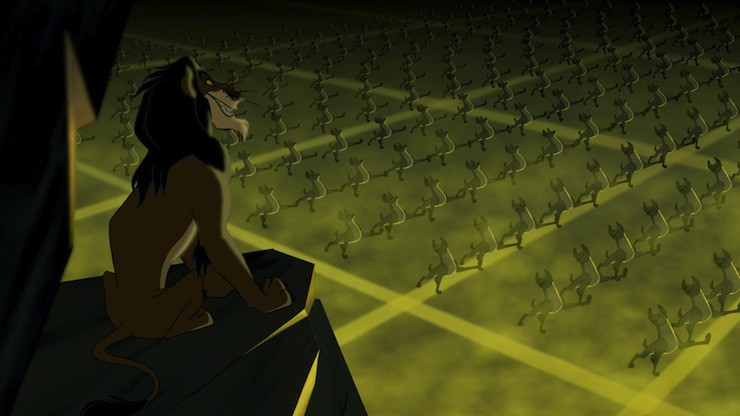
And The Lion King believes, unquestionably, that everything in the Pride Lands has gone wrong because an illegitimate ruler is on the throne; Bambi believes that everything in the forest has gone wrong because humans are around. Also, because bad things happen. It’s safe to say that both Hamlet and Bambi were at best distant inspirations.
A more direct inspiration may have been Kimba the White Lion, a Japanese anime from 1965. Some critics, indeed, have refused to use the word “inspiration” and instead chosen the words “outright plagiarism,” an accusation that gained traction after stories began to spread that Matthew Broderick, who voiced the adult Simba, was under the impression that he was voicing a U.S. version of Kimba the White Lion, or outright dubbing the original Kimba the White Lion, instead of voicing an entirely new character for an entirely new film. It is worth noting, perhaps, that Texuka Productions, owners of the rights to Kimba the White Lion, declined to sue Disney over this. Disney has firmly denied all accusations of plagiarism.
For the record, I haven’t seen Kimba the White Lion in English or Japanese, so I have no opinion on this. But, let’s assume for a moment that Disney was lying through their teeth here, and The Lion King is a remake of Kimba the White Lion, and not “Lions try to do Shakespeare, with a Nazi scene and some hula dancing.” That still makes The Lion King an adaptation of a film, not a literary source.
And yet I’m tossing the film into this Read-Watch anyway, partly because of requests in the comments, and because, whatever its inspiration, The Lion King proved to be a landmark film for Disney, arguably one of the most influential—and certainly the most popular—in decades.
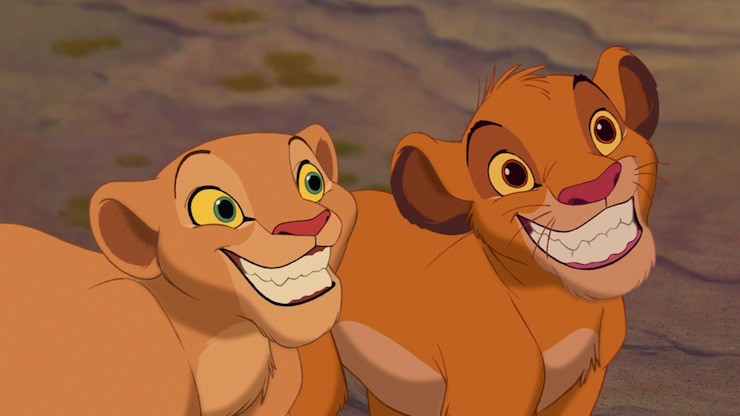
Like many of the early Disney films, the idea for The Lion King came from the very top—in this case, a conversation between Disney executives Roy E. Disney, Jeffrey Katzenberg and Peter Schneider back in 1988. At the time, they were launching Oliver and Company, a film about cute singing animals, and thought that just possibly, another film about cute singing animals—set, perhaps, in Africa, a continent Disney had not yet bothered to animate or pay any attention to, might be a good idea. (Katzenberg had a decided weakness for cute singing animals.) If anyone thought that just perhaps having Disney’s very first animated film set in Africa be about animals, instead of people, was not necessarily the best idea, that thought has not been recorded. Especially since this particular idea ended up making Disney a lot of money.
Getting to that money, however, turned out to have a number of obstacles. Disney’s top directors and animators were, at that point, focused entirely on little mermaids, and were soon to be equally obsessed with beasts and singing furniture. No one could quite grasp what the story was about, in part because Katzenberg kept offering suggestions. The script went through multiple revisions before Kirk Wise and Gary Trousdale, exhausted from working on Beauty and the Beast, were able to take a look at the film and start supervising storyboard and script changes. Even after they came on board, the story and script continued to undergo almost endless last minute tinkering.
To add to the issues, Disney executives once again insisted that at least part of the film be animated in the Florida studio, beneath the waiting eyes of tourists—although at least in this case they did not insist that animators on two different coastlines attempt to animate two characters in the same scene. Instead, the Florida animators ended up doing some of the scenes with little Simba and Nala, including the “I Just Can’t Wait To Be King” sequence, which perhaps explains why that song looks so incredibly different than pretty much anything else in the film: it was designed and animated by different people.
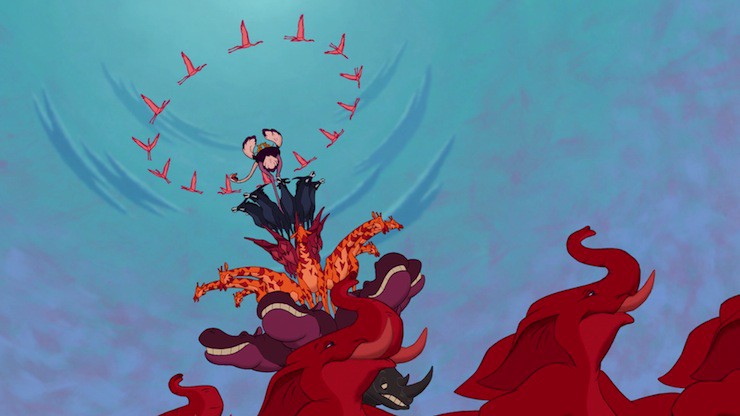
The inconvenience didn’t upset everyone in the animation department—after all, someone threw in something increasingly popular from the theme parks—not one, but two hidden Mickeys. Watch very closely during “Hakuna Matata” and when Mufasa is droning on about YAY KINGS IN THE STARS. And I’m just going to skip over the implications of having Mickey up there right along with the other starry kings. But it still added a technical difficulty to the process.
But the fundamental problem was more basic than script issues, communication and design, and coastal differences: None of the animators really wanted to work on this film.
As animators have since admitted, the big film for Disney at the time was Pocahontas, which went into production at about the same time. Pocahontas was Disney’s serious, big prestige film, the one every animator wanted to be working on. The Lion King, even with Jeffrey Katzenberg taking an interest and continually making (often unwanted) suggestions, was clearly just another silly animal film.
Fortunately, Andreas Deja, who had just animated villains Gaston and Jafar, agreed to work on Scar. Other animators were mollified by the idea of working with animals, especially after—in a continuation of Disney history—the studio brought in live lions for the animators to look at, and sent other artists to Africa for design and concept ideas. Plus, the entire animation department was growing increasingly excited about what could be achieved with the still new CAPS (Computer Animated Production System) and suggested that maybe the new animal film could make use of that. Gradually, some enthusiasm for the little lions began to build.
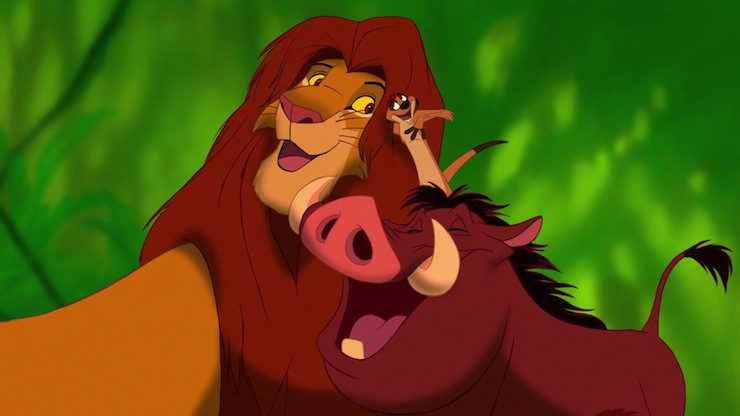
The musicians, on the other hand, turned out to be more enthusiastic, with lyricist Tim Rice, still doing final tweaks on Aladdin, even helping to recruit Sir Elton John. As it turned out, the singer didn’t need all that much persuading—he loved Disney films. The collaboration was a definite success: three of the five songs they wrote for the original film would go on to be nominated for Academy Awards, and one, “Can You Feel the Love Tonight,” would win. The experience wasn’t entirely positive: Rice had to convince the producers that “Can You Feel the Love Tonight” would not exactly work as a love ballad if comedy character Timon sang all of it, and legend claims that the song didn’t even appear in an early screening of the film. (Some Disney sources dispute this account.)
For the rest of the soundtrack, Disney hired composer Hans Zimmer, who in turn brought in South African composer Lebo M to help establish an African feel to the film. The two started off by working on “Circle of Life,” a song Elton John reportedly tossed off in just a few hours. Originally, it was intended to be a nice, typical Disney opening number—bracketed by amusing dialogue, introducing us to various characters—in short, more or less what the film did get with “Hakuna Matata.” Zimmer and Lebo M, listening to the tune, and reading the original lyrics, had a thought: why not open the song with Zulu vocals, and maybe extend it a little? They presented their revised version to the filmmakers with some trepidation, expecting—understandably—that the song would get severely cut.
Instead, it led to one of the most famous sequences in Disney animation history.
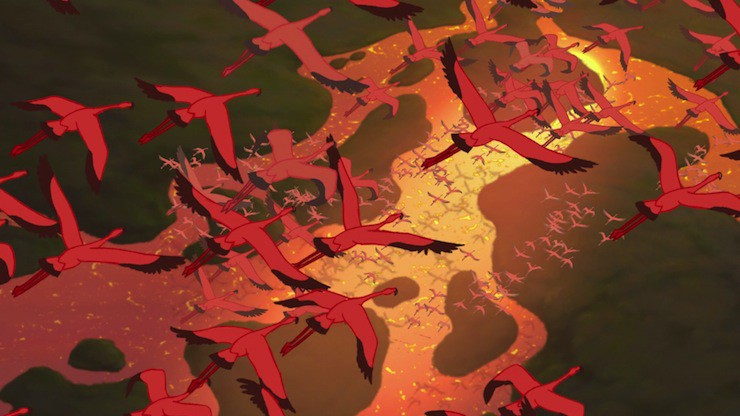
Enthralled by the new version, animators tossed out the dialogue that was originally supposed to bracket “Circle of Life,” instead producing something entirely new: a showcase of the very best in Disney animation, featuring a shimmering waterfall, a sequence of flying flamingos in proper perspective, shadowy elephants and gazelles moving through fog (featuring, unusually enough, multiple moving characters), and soaring camera movements created by CAPS. Also a rather cute little baby lion. It was arguably Disney’s greatest piece of animation since Fantasia, and rarely outdone since.
Animators, indeed, got so invested in the sequence that, despite the issues they were having animating the tiger over on Aladdin, they decided to just go for it and add zebras. Stripes are notoriously difficult and expensive to animate by hand (see, also, why the Winnie the Pooh shorts initially left Tigger out and later limited his screentime, and why The Little Mermaid’s Flounder is a one color fish), and animators here not only had multiple zebras trotting, but also has the zebras trotting through dust beneath a separately animated bug, and later splashing through water, and then, kneeling.
Some critics (this blogger included) have, admittedly, questioned whether or not herds of animals would, in fact, walk or run through a sunrise filled with fog just to see a small cub dangled over a big rock—a small cub that, moreover, would soon grow up to eat them. Even if the animals looked great doing so. Other critics objected to the sequence’s not particularly subtle pro monarchy message—although I would argue that this message is less pro monarchy and more Disney’s attempt to create a fairy tale rather than animate one.
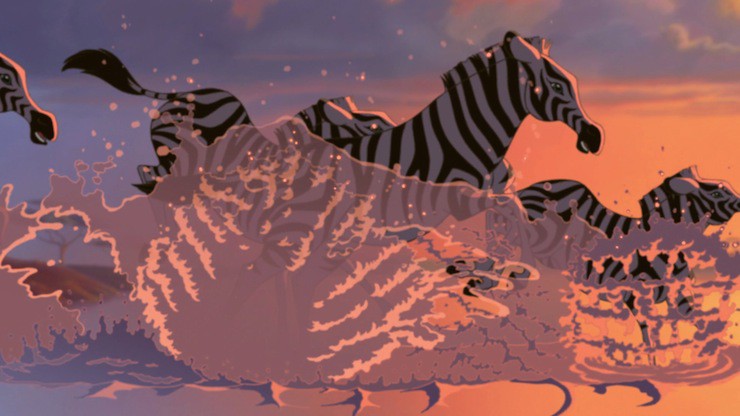
By this, I mean that the scene—little Simba presented to his subjects—is straight out of myth and folklore and fairy tale, which often contain scenes presenting the newly born protagonist to magical creatures. That folklore connection becomes even stronger in a later scene, when, after the false king Scar takes over as king, the lands around him become barren and dead. Even the rain stops falling. This is not natural, and although the hyenas get blamed for this, they can’t exactly be blamed for the lack of water. That has happened because the true king isn’t present.
None of this is particularly democratic, granted, and the YAY KING message at the end of the film pretty much slams shut any happy thoughts brought on by the hyenas’ earlier calls for “NO KING NO KING.” The Lion King also never stops to consider that just maybe the whole inheritance thing is what’s causing the problem in the first place—after all, Scar only gets to claim the throne because he’s the brother of the previous king. Eliminate the heredity, and you have a chance for a new lion king who (a) won’t manipulate poor, starving hyenas for his own evil ends and (b) won’t just roll around eating bugs and (c) is inspired not by a hallucination of talking stars, but a desire to lead.
But The Lion King isn’t a takedown or aristocracy, much less fascism, even if one sequence featuring Scar borrows Nazi imagery. It’s a fairy tale that wants the prince to have a triumphant return.

Fairy tales also probably helped inspire the film’s second astonishing animated sequence: the horrifying moment when Scar and the hyenas incite a herd of wildebeests to stampede, nearly killing little Simba, and killing Mufasa, who showed up to save him. Even Scar, for a moment, looks horrified as he watches the stampede—although this horror soon turns to triumph when, instead of saving Mufasa, he allows his brother to tumble down into the wildebeests. It echoes many fairy tales of princes cast out of their lands by relatives and monsters.
Frankly, those two sequences—the opening and the wildebeest stampede—are so powerful that the rest of the animation can seem pale in comparison, but there’s still some lovely stuff here. It’s also a nice change to have a romance between two Disney characters who were friends before feeling the love tonight. We’ll just try to overlook the fact that since Simba and Nala live in the same pack, a pack that only seems to have two adult male lions around, both brothers, they are almost certainly at least cousins, and possibly half siblings… I said we would try to overlook this. And as someone who has perhaps been to Walt Disney World a few too many times, I must admit to laughing out loud at a certain musical joke involving a certain infamous attraction that can be found at Walt Disney World and Disneyland.

I am, certainly, left with some quibbles. How exactly did this ritual of allowing a mandrill to dangle a small baby lion off the edge of a cliff develop? And speaking of this mandrill, when, exactly, did he learn martial arts, and who, exactly, taught him? Are the animals in “I Just Can’t Wait To Be King” singing along in the hopes that if they do, they won’t get eaten, or because they, too, kinda side with Scar on the “Get Rid of Mufasa” thing and figure that a cute little lion cub has got to be better than a king who forces them to bow down to the lion cub that’s going to eat them? What is the anteater doing in that scene? How, in the barren land that Scar created out of Pride Rock, did Timon find enough grass to make a grass skirt and do the hulu? Or does Timon just carry long blades of grass around for just that sort of emergency? Can a little lion like Simba really grow to full size on a diet of bugs? What’s with this desert that appears between the Pride Lands and where Timon and Puumba live? Why does not one lion ask Scar for proof that little Simba is dead?
And bigger questions: Why, exactly, in a film about taking personal responsibility seriously, is one of its most memorable songs—Hakuna Matata—all about avoiding that responsibility? It’s the African savannah—where are the leopards and cheetahs? (Actually, I do know the answer to that one—”cut from the script.”) And finally, how did Scar get all of the minor volcanic eruptions to explode on cue like that during his song, not to mention getting a pillar of stone to lift him to the sky at the appropriate moment?
Not to mention, with power like that, why is he bothering with just Pride Rock? Aim higher, Scar! Aim higher!
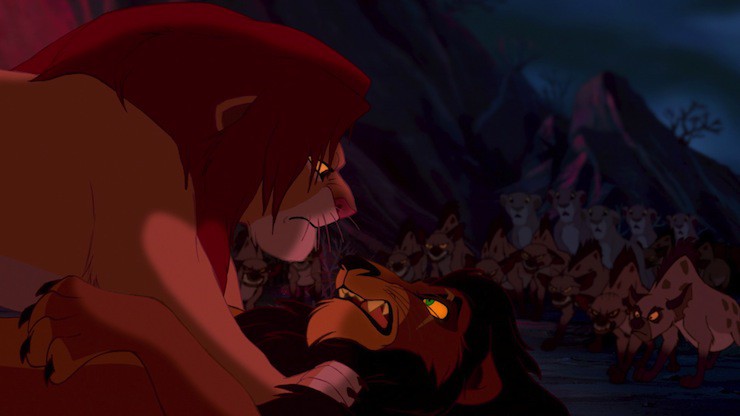
It’s safe to say that audiences completely ignored these quibbles. The Lion King smashed Disney and other box office records, bringing in an initial $768.6 million in its initial worldwide release. Later releases in IMAX and 3D, in 2002 and 2011 respectively, while screaming “marketing gimmick,” brought the overall box office totals close to $1 billion, leaving The Lion King as number 25 in terms of all time highest grossing films before any adjustments for inflation. As of this writing, only three animated films, Toy Story 3, Frozen and Minions, have been more successful. All of those, of course, were computer animated, leaving The Lion King as the top grossing hand animated film of all time.
(Though it’s perhaps only fair to note, that, adjusted for inflation, Snow White and the Seven Dwarfs beats all four, though it’s also only fair to note Snow White has benefited from multiple releases.)
The Lion King proved a marketing blockbuster in other ways as well, spawning toys, and attractions at all Disney theme parks, as well as two sequels: Simba’s Pride, which, as Disney direct-to-video sequels go, could be worse, and Lion King 1 ½, which is. Financially, however, The Lion King’s most important legacy for Disney turned out to be, not toys or subsequent releases, but the Broadway stage production of The Lion King, which eventually becoming the highest grossing Broadway show in history.
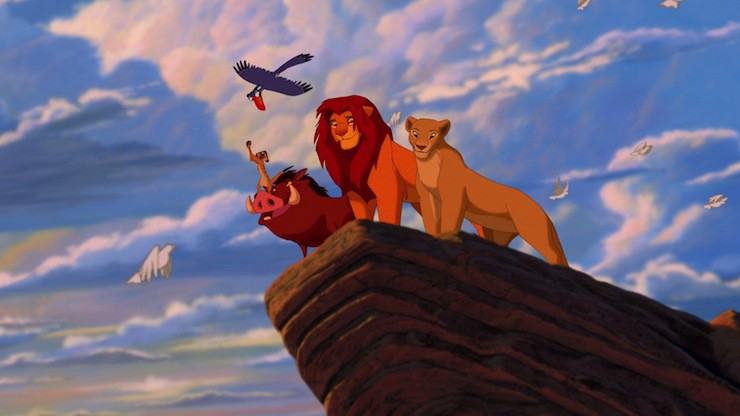
The film had one other, subtle, influence. Although all four films had received similar marketing budgets and critical praise, Aladdin and The Lion King had made far more money than The Little Mermaid and Beauty and the Beast. Disney executives believed they knew why: small boys were not interested in seeing films about girls, though boys—human or lion—were box office draws.
As a result, until the launch of the Disney Princess franchise, Disney Animation chose to focus on films featuring boy protagonists, with the notable exceptions of Pocahontas (then receiving its finishing touches), Mulan (which went into formal development before The Lion King was released in theatres), and Lilo and Stitch (where the trailers focused on Stitch.) Had Disney been able to foresee Frozen, the studio might have made different choices.
At the time, however, they were looking at the box office results for their prestige film, Pocahontas.
Coming up next: the selected writings of Pirate er Captain John Smith.
Mari Ness lives in central Florida.










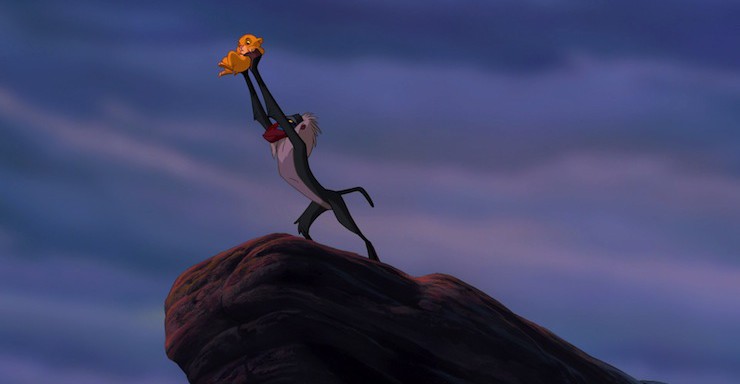
I’ve always had the impression that the reason the makers of Kimba didn’t sue Disney wasn’t because they didn’t believe they’d been plagiarized, but because they knew they had no chance of winning against Disney’s massive army of lawyers.
The only thing that surprised me was rating Lion King 2 above Lion King 1 1/2. I absolutely love 1 1/2, but 2 is terrible.
Come to think of it, on the subject of sequels/offshoots, there was also a Timon & Pumbaa TV series spinning off from this.
Oh, Lion King. How do I love thee, let me count the ways. 1. Shenzi 2.Banzai 3.Ed.
OK, there are many other wonderful things in the film, and many more — including nine extra songs — in the spectacular stage adaptation. But the hyenas were the first villains I ever loved, and I adored them from early childhood well into adolescence. And I still sleep with a hyena plushie, though not a Lion-King-type one.
Oh, some people in the audience noted the quibbles you pointed out, though perhaps not as young children. And more issues, as I’ve learned from a certain person’s “Black Hat Brigade” blog series, which regularly features Simba, Scar, and other characters in meta discussions of logistics and ethics.
The Lion King 1 1/2 is almost as absurdly AU as the TV show, but I quite enjoyed some parts of it. I looooved the premise of The Lion King 2, but feel it fell far short of its potential, further marred by small annoyances like Nala having blue eyes.
Great article as always, thanks. (This is also the point where I stopped watching Disney movies until I had kids, so I will be interested to see what I missed!)
Not only the Timon & Pumbaa show but the new Lion Guard show that my kids watch repeatedly on demand.
Why, exactly, in a film about taking personal responsibility seriously, is one of its most memorable songs—Hakuna Matata—all about avoiding that responsibility?
I think that’s precisely the point. Avoiding responsibility is tempting and seems very fun, doesn’t it? Every Tom Sawyer has his Huckleberry Finn.
Okay, first I’m going to be THAT guy by pointing out that the Danes were not invading in Hamlet. The Norweigians were.
When I saw Aladdin with my then-girlfriend, they showed a trailer for Lion King that was just the opening number Circle of Life. Jaws were on the floor. She turned to me and said, “oh we’re going to that!” I don’t think I have ever wanted to see an animated film more than that. I still get a little water in the eyes when I think of it.
Right…I mean, really, you could say the same about The Jungle Book and ‘Bare Necessities’.
I kind of had a thing for Jeremy Irons around this time, heh.
Oh, and regarding Hamlet – do you have a source for Disney actually claiming that, because I always thought it was a fannish theory (and not one I particularly agreed with for the various reasons you note).
Watching The Circle of Life trailer was seriously a transformative experience. The animation was so amazing, and Lebo’s work so impressive, it couldn’t be ignored. I was a kid then, and it was the first movie I remember crying during. It also completely shaped my future career. I went from drawing everything with no future plans, to injecting some cartoon stylization and wondering about being an animator. (I’m not, because about the time I got to college and really considered it, I could see everything moving to 3D which I had done in HS and found I wasn’t too crazy about. Also the huge amount of secret work you had to do, for years, with no ability to create work independently w/ any regularity. Nah.)
The whole second soundtrack that was produced of almost totally Lebo M’s work for The Lion King (the one which they went back to for additional tracks in the Broadway show) is still my favorite Disney soundtrack of all time. He and his ensemble just totally kill it.
I don’t get the confusion here. The Lion King has the same relationship to Hamlet as Pocahontas has to Romeo and Juliet / West Side Story. There is hardly a story beat in tLK that doesn’t come from Hamlet, Bambi, or Jungle Book.
Don’t forget The Lion Guard, now halfway through its first season on BitTorr… er… DisneyTV. Its actually not bad as far as TV adaptation sequel series go – far more watchable with kids than I was afraid it was going to be.
@mirana – Are you referring to The Rhythm of the Pridelands? Love that album – its really well done, too, and sounds amazing on some high-dollar kit, especially Kube and Lea Halalela.
Lisamarie – The producers mention the Hamlet inspiration in the “Story Journey” and “Film Journey” features, which were included on the 2nd DVD disc released with the Platinum Edition in 2003.
Admittedly, at other times Disney has claimed that The Lion King is a Disney original. It might just be whatever the Disney marketing team wants to focus on at the time.
Colomon – Although it’s possible that Disney animators were influenced by Romeo and Juliet/West Side Story while making Pocohontas, and Disney was tossing around the idea of animating Romeo and Juliet before putting Pocahontas into production, the timing strongly suggests that the major inspiration for Pocahontas was Dances With Wolves.
What’s this musical joke at this infamous attraction? Totally over my head…
@16, I think Zazu (in the bone cage) starts singing “It’s a small world after all” and Scar says “anything but that”.
@16 — Scar asks Zazu to sing something “with a little bounce in it.” Zazu sings “It’s a Small World After All.” Scar reacts in horror and modifies his request to “anything but that!”
I’m going to also be “that guy” right along with @8 and point out that Hamlet wasn’t content in waiting to be king. He complains about Claudius stealing his throne on several occasions during the play, including to Horatio, the one character he never lies to. Since he can’t be king thanks to his uncle, he’d rather leave the whole soap opera mess of his family behind and go back to college–at least until his father’s ghost shows up and gives him purpose–but he never indicates he’s happy about having to wait his turn. Quite the opposite.
And the differences between Lion King and Hamlet don’t strike me as that drastically out of line with the differences between Oliver and Company and Oliver Twist: it hits enough story beats to be recognizable as an adaptation, but strips out everything too unsavory for children and replaces the characters with animals, many of them comic relief. I definitely buy it as an intentional (albeit loose) adaptation, especially given that Lion King 2 deliberately did the same thing with Romeo and Juliet, and Lion King 1 1/2 riffed on Rosencrantz and Guildenstern are Dead.
@1: I grew up seriously nutty on Kimba the White Lion. I could probably, (if prompted when sufficiently lit up) sing the entire theme song, 40 years later… (But I doubt I’d do it unless my audience was in a similarly altered state). I’d say Simba pretty much is a flat-out rip-off of Kimba. I was stunned that the studio didn’t sue Disney. But your explanation makes complete sense. The Mouse That Roared and then Ate the World would have been able to drag it out forever…
Took a long time for me to even go see the movie, I was so mad about it.
The Mouse that what?! *looks it up* Goddessdamnit. I need a film where an actual mouse actually eats the world.
Not all the animators go to go to Africa. There used to be a colony of spotted hyenas at UC Berkeley, in the hills above the campus. A lot of research on hormone effects was done there over the years. (Female spotted hyenas have unusually high levels of testosterone. And that ain’t the half of it.) A UC biologist professor once told me that Disney sent a delegation of “Lion King” animators up to Berkeley to observe the beasts. The captive hyenas, being aggressive and fractious creatures, had had their fangs removed to prevent them from seriously mauling each other. The animators thought that was how they came naturally, and represented the hyenas in the film as fangless. So I’m told–I’ve managed never to see the movie, and why risk spoiling a good story?
I went to see The Lion King on Broadway without having seen the movie (I did see it after). One of my companions said, “I don’t know if you’d be able to follow the play if you haven’t seen the movie.” Once we hit intermission, I turned to him and said, “What makes you think I’d have trouble following the play? It’s Hamlet with manes!”
I disagree with the headline, is all I’m sayin’. :)
—Keith R.A. DeCandido
mrpalmtree19@2: Agree! Lion King 1 1/2 is hilarious, while Lion King 2 has terrible animation and an even more terrible story.
And as someone who saw Kimba the White Lion as a kid, I found it ridiculous that not only Disney said that Lion King was not inspired by Kimba (which is possible), but also that there weren’t any similarities whatsoever. Except the father lion being killed, the mother’s face appearing in the stars to guide him, the young lion changing his diet to adapt to his new friends…
But then they did the same thing with Atlantis, since (according to them, at least) apparently no one at Disney had even heard of The Secret of Blue Water during the production of the movie.
Of possible interest: Hamlet is, at root, the same story as the Middle English romance Havelok the Dane. As in, there is a lost original they both come from. Havelok inspired William Morris’ Child Christopher and Goldilind the Fair, and Lewis’ Prince Caspian.
Havelok/Child Christopher/Caspian has more in common with TLK than any of them does with Hamlet IMO.
@24 — I had never heard of Havelok, thank you!
Tracing back the origins of the Hamlet myth is fascinating. The Scandinavian legend of Prince Amleth, the direct inspiration for Hamlet, was written down twice in the 12th century and is believed to go back at least to the 10th, though the presumed 10th century source hasn’t survived. However, Saxo’s 12th century retelling in the Gesta Danorum has a lot of marked (and almost certainly not coincidental) similarities to Livy’s account of the vengeance of Lucius Junius Brutus, which was written in the 1st century B.C. Shakespeare’s is the best known adaptation of the myth, but it was far, far from the first…
I’ve never seen Kimba the White Lion, but I looked on wikipedia (sorry!) and the story appears to bear very little resemblance – humans are the encroaching enemy, but in the end “only communication and mutual understanding will bring true peace”. Is it that the character of Kimba is very similar to Simba (in more than just name)?
I still remember one time when my sister and I were downstairs listening to music – possibly including the Lion King soundtrack – and our mom came in to tell us there would be no school tomorrow, it would be a snow day. Without even thinking about it we both burst out in an echo of the Hyenas’ “No king, no king, la, la la, la la la!” and sang/shouted “SNOW DAY, SNOW DAY, LA, LA LA, LA LA LA!!!”
If you like hyenas and you haven’t read Ursula Vernon’s “Digger”, you should check it out! The main character is actually a wombat whose tunnel gets moved so that she is stranded in a strange place, and among other strangers she encounters a tribe of hyenas. Here’s a good sample page:
http://diggercomic.com/blog/2007/03/08/digger-41/
Sorry, I meant to say “only communication and mutual understanding between the two species will bring true peace.” Lion King does involve understanding between species – but humans are nowhere in the picture and SHOULD NEVER BE.
Self-edit: The stage version includes eleven new songs, not nine. And all of them are fabulous. If you can’t watch the play, just listening to the soundtrack is worthwhile.
Fun fact: Jeremy Irons (who voiced Scar) narrated a documentary called The Last lions, which I recall myself describing as the backstory that The Lion King 2 should have gotten.
I once heard that a hyena researcher sued Disney for defaming hyenas. This made me very happy.
I hate to point out typos, but it’s “Tezuka”, not “Texuka”. Unless this is also about a Dixney film; and “hula”, not “hulu”, unless Timon created an online video streaming service out of grass. (And Timon’s pal is Pumbaa, not Puumba, but I ran out of puns.)
And really, people complain about herds of animals running to go meet a lion cub? In a film where ANIMALS TALK AND ARE SENTIENT BEINGS?
@@@@@ 24 Makhno, 25 SKM: Another point of interest, when I took a class on Classical Mythology in college, one paper I wrote not only compared Hamlet and The Lion King (and Rosencrantz and Guildenstern Are Dead), but addressed how all of them draw even farther back on the myth of Orestes, Agamemnon, Clytemnestra, and Aegisthus. (Note that at one point Orestes was betrothed to his own cousin…)
#7/Sketchy:
Right. There’s a long musical tradition, particularly in stuff targeted towards children, of having it Both Ways with songs like this. Just in the Disney realm, Pinocchio has “Hi-Diddledy-Dee”, Jungle Book has “The Bare Necessities”, Goofy sings “The World Owes Me a Living” in Aesop’s Fables. These are all basically the same song as “Hakuna Matata” and are always used to set up the eventual lesson. It’s only coincidence that more often than not, these are the parts that stick in our memory and become classics.
guys, have you noticed how kion isn’t in any of the family tree’s or isn’t seen in lion king 2 even at his own sister’s wedding. my theory is that kion was adopted (note just came up with it). think, he ain’t in no family tree and he wasn’t even seen or heard of in tlk2 especially weird in the first part when kiara meets kovu. Possibly since the death of Kopu Simba and Nala felt intense grief so they adopted kion because he has great resemblance to Kopu. the reason he wasn’t at the wedding might be said as being a high priority “mission” or might hurt him because of him knowing he was adopted so he went somewhere not to be known and that brings us to now. I hope you liked my first tlk theory and cyan dudes ?